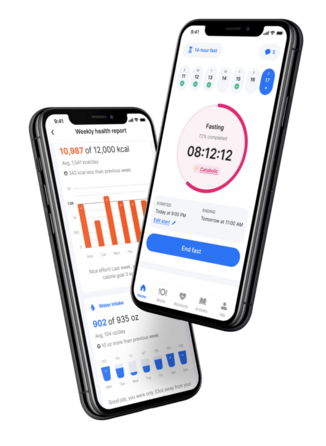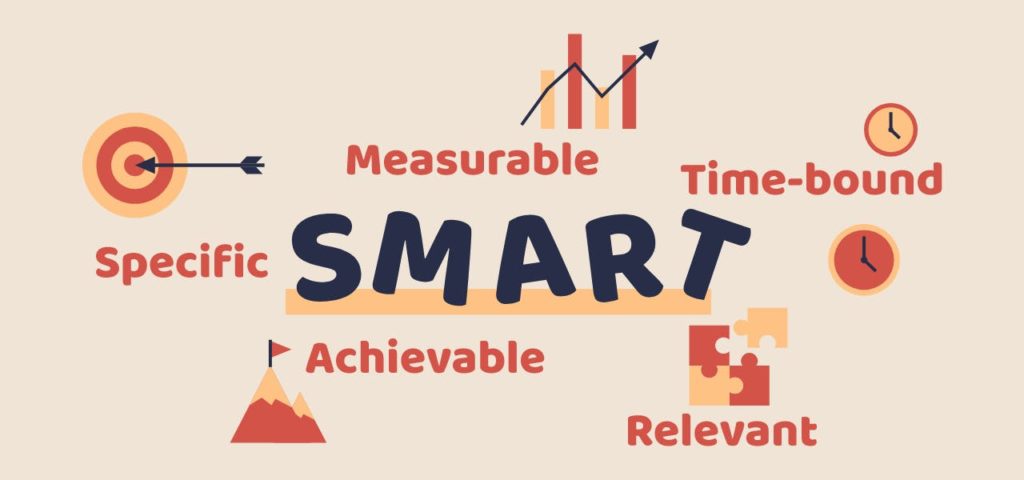Contents
What Does S.M.A.R.T. Stand for?
Specific. Measurable. Attainable. Relevant. Time-bound. Setting these measures and combining them with intermittent fasting (meal timing schedule) will bring you closer to your goal weight faster than you might think.
Also, weight loss results reached using this method are more likely to stick than those achieved without any framework–chaotically. Here’s how to utilize the S.M.A.R.T. goal-setting plan and lose weight with it.
Take a
1-minute quiz
and discover how much weight you can lose with DoFasting!

Specific
Be precise about your goal. Lowering B.M.I. is not specific enough. However, losing 10 pounds is. To decide what your aim is, you also need to know where you’re starting. Weigh and measure yourself before starting your weight loss journey. Decide on the specific goal and go with it.
When it comes to fasting, it is also necessary to define your meal timing schedule. There are many protocols to choose from. The most popular is having an 8-hour eating window and then fasting for 16 hours.
However, if this seems too complicated, starting slow and having a 14-hour eating window is also a good choice. For males, it is recommended to choose the 16:8 method while females can safely practice the 14:10 pattern. Example of specific goal setting: ‘My goal is to lose 10 pounds (for now). I will start by having an 8-hour eating window every day.
Measurable
To achieve your goal, you need to make sure you can measure the progress. This means that taking 10 thousand steps is not the goal you should set if you do not have the device to measure them. It might be challenging to track health indicators yourself, so your physician’s examination is a good idea. Find out your health state and then set specific, measurable goals with your doctor.
Next time you have an appointment, repeat the same tests, and you’ll determine your progress. Don’t forget to be specific. Undergoing medical examination is especially useful if you’re going to be fasting. Eating within specific time windows provides health benefits that can be difficult or sometimes impossible to measure by the naked eye.
For example, you might want to know the percentage of your visceral fat before starting. Set a goal to lose at least 1% of this harmful fat surrounding your organs, and make sure to check if you’ve achieved it with the doctor next time you meet them.
Example of measurable goal setting: “My goal is to lose 1% of visceral fat, 10 pounds, and eat within 8-hour windows.” “I’ve learned the visceral fat percentage from my physician, and I’ll be able to check on it with them later.” “Also, I’ve got the scales to measure the weight at home.”
Take a
1-minute quiz
and discover how much weight you can lose with DoFasting!

Attainable
When setting a goal, it is essential to make sure that it is achievable. Of course, losing 50lb with one meal a day fasting protocol seems like a worthy goal; however, consider if you’ll be able to follow the routine long enough.
Unattainable goals may quickly discourage you from having any plan whatsoever. Instead, go small, and you will always be able to adjust your goal. If you want to lose 100lb, start with just 2lb. If you want to start intermittent fasting, but sticking to the eating windows sounds like a challenge, maybe just learn about food combinations for weight loss at first?
Or, if you are generally not sure if you should start, set your goals by making a list of the pros and cons of intermittent fasting. Reaching small goals are both attainable and motivating.
Relevant
When setting a goal, ask yourself if it is relevant to your life. What and how will change when you reach the goal. What meaning does this goal have to you personally? The good thing is that any weight loss-related goals are usually highly relevant to the person trying to achieve them.
Pounds lost translate into better health, higher self-esteem, more quality time with friends and family, less frustration, and so on. Whatever meaning you give to your goal will help you get back on track after a setback.
If you are not sure why you’re losing weight or are happy with where you are, you will most likely not reach any weight loss goal. It is simply not relevant to you. Example of relevant goal setting: “When I start an intermittent fasting routine and lose 10lb, I will feel more energetic. I will have more clothes that fit me. My health will improve, and I will be able to spend more time with my grandchildren.”
Time-bound
Consider there is no goal if it doesn’t have a deadline. There must be a specific time within which you should be able to reach your goal. For a beginner ‘goal setter,’ it is best to have short-term goals. When it comes to intermittent fasting and weight loss, set daily or weekly goals, pay attention to all previously discussed facts, and adjust accordingly.
Example of time-bound goal setting: “My goal is to lose 1lb (specific and measurable, because I have scales at home and attainable based on my body and previous experiences) in one week (time-bound) while following a 16:8 intermittent fasting routine.” “I will feel better about myself, knowing that I can reach my goals. It will help me set further weight loss plans (relevant). I will adjust my goals weekly to reach the best results.”
Final Word
To lose weight, one has to be serious and specific about setting goals correctly. Using the S.M.A.R.T. framework will get you closer to your dream body. You will feel more confident and motivated about the process. A goal set correctly is the first step to weight loss success.
FAQ
1. What are the 5 S.M.A.R.T. goals?
Specific. Measurable. Attainable. Relevant. Time-bound. Setting these criteria will bring you closer to your goal faster than you might think. Also, results reached using this method are more likely to stick
2. How do you write a smart goal for weight loss?
Specific.
Be precise about your goal. Lowering B.M.I. is not specific enough. However, losing 10 pounds is. To decide what your aim is, you also need to know where you’re starting.
Measurable.
To achieve your goal, you need to make sure you can measure the progress. For example, 10 thousand steps per day is a great goal if you have the device to count them.
Attainable.
When setting a goal, it is essential to make sure that it is achievable. Unattainable goals may quickly discourage you from having any plan whatsoever. Instead, go small, and you will always be able to adjust your goal.
Relevant.
When setting a goal, ask yourself if it is relevant to your life. What and how will change when you reach the goal. The good thing is that any weight loss-related goals are usually highly relevant to the person trying to achieve them.
Time-bound.
Consider there is no goal if it doesn’t have a deadline. There must be a specific time within which you should be able to reach your goal. For a beginner ‘goal setter,’ it is best to have short-term goals–daily, weekly, or monthly.
Take a
1-minute quiz
and discover how much weight you can lose with DoFasting!

Leave a Reply
See how DoFasting will improve your life
Find out what works for you with this 60-sec quiz approved by our experts and get your personal revolutionary fasting assistant.
Start the Quiz
This is an evidence-based article that includes scientific citations. DoFasting’s professional writers and editors prepared the content, which a team of medical experts verified to be accurate.














2 Comments
I am not sure where you’re getting your information, but good topic. I needs to spend some time learning much more or understanding more.
Thanks for fantastic information I was looking for this info for my mission.
Thank you! It’s never too late to learn something. 😊